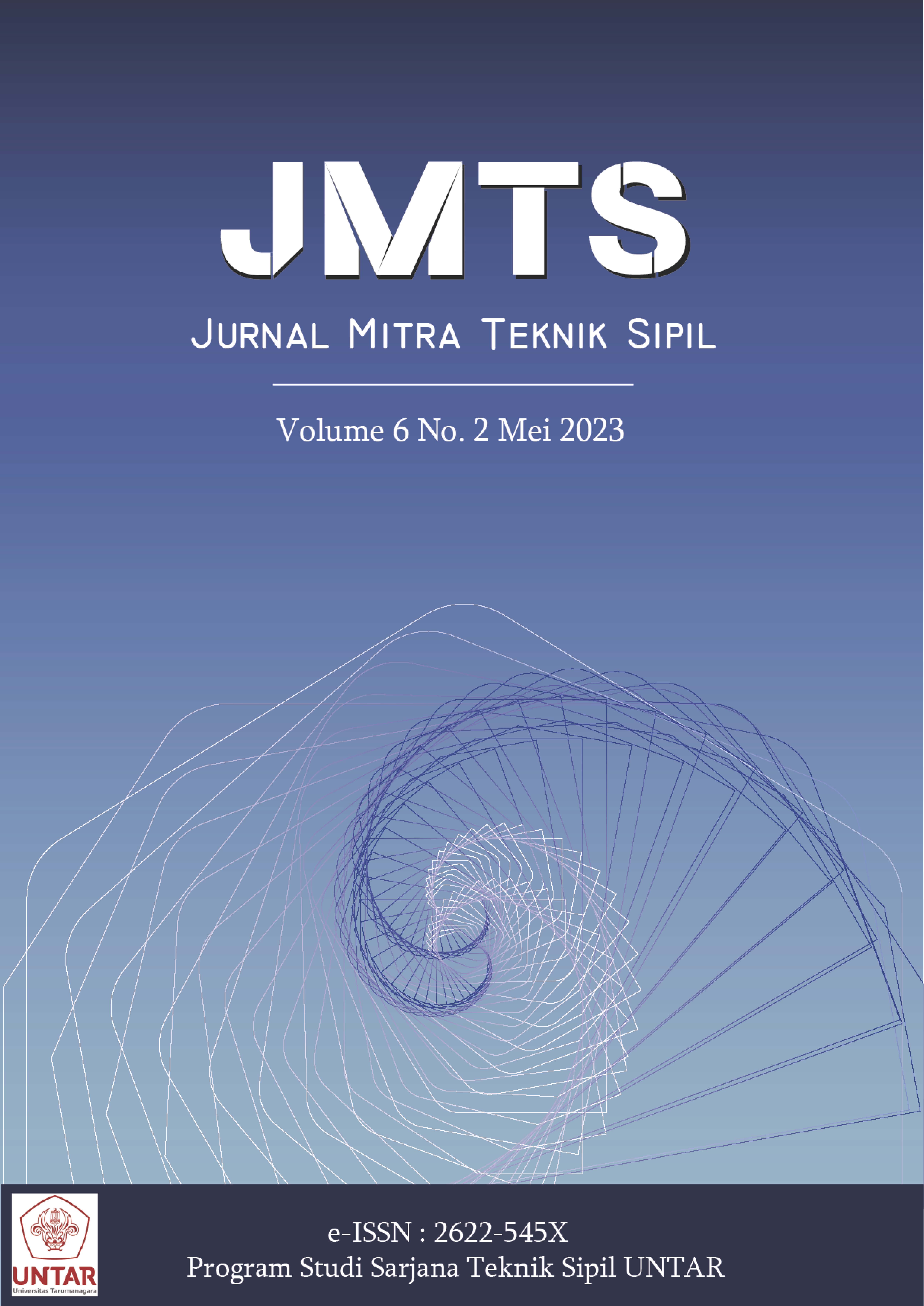METODE PAIRED COMPARISON PADA PEKERJAAN PONDASI BANGUNAN GEDUNG DENGAN PENDEKATAN STUDI VALUE ENGINEERING (VE)
Main Article Content
Abstract
Foundation work is one of the most crucial jobs in building construction. Therefore, an appropriate method is needed to determine the most effective and efficient type of foundation. One of the methods used is the paired comparison method with a value engineering approach. In this case study, the paired comparison method is used to compare the square pile foundation (existing) with the use of a triangular pile design and round piles. The total budget is Rp. 3.834.143,026,84. The analysis shows that the D-300 round pile foundation has the highest cost among the three with a total budget of 4.522.511.665.00. Based on the design scenario, square foundation work is superior in the financing, implementation time, amount of labor, concrete quality, and weather conditions in the field with a total value of 54% than the triangular and round pile foundations. Hence the final decision remains to use a square pile foundation.
Abstrak
Pekerjaan pondasi merupakan salah satu pekerjaan yang krusial dalam pembangunan gedung. Oleh karena itu, diperlukan metode yang tepat untuk menentukan jenis pondasi yang paling efektif dan efisien. Salah satu metode yang digunakan adalah metode paired comparison dengan pendekatan value engineering. Dalam studi kasus ini metode paired comparison digunakan untuk membandingkan pondasi tiang pancang persegi (eksisting) dengan penggunaan desain tiang pancang berbentuk segitiga dan bulat. Total anggaran dana yaitu Rp. 3.834.143.026,84. Hasil analisis menunjukan bahwasanya pondasi pancang bulat D-300 memiliki biaya yang paling tinggi diantara ketiganya dengan total anggaran 4.522.511.665,00. Berdasarkan skenario desain bahwa pekerjaan pondasi persegi lebih unggul dari segi pembiayaan, waktu pelaksanaan, jumlah tenaga kerja, mutu beton serta kondisi cuaca di lapangan dengan total nilai 54% dari pada pondasi tiang pancang berbentuk segitiga dan berbentuk bulat. Oleh karena itu keputusan akhir tetap menggunakan pondasi tiang pancang persegi.
Article Details

This work is licensed under a Creative Commons Attribution-NonCommercial-ShareAlike 4.0 International License.
This work is licensed under Jurnal Mitra Teknik Sipil (JMTS) Creative Commons Attribution-ShareAlike 4.0 International License.References
Ardiansyah, M. K., Irawan, S., & Purba, H. H. (2022). Identifikasi Faktor Risiko Keselamatan Pada Proyek Konstruksi Bangunan Gedung Di Indonesia Dalam 10 Tahun Terakhir (2011-2021): Kajian Literatur. Jurnal Teknologi Dan Manajemen, 20(1), 45–58. Https://Doi.Org/10.52330/Jtm.V20i1.46
Arumsari, P., & Tanachi, R. (2018). Value Engineering Application in a High Rise Building (A Case Study In Bali). IOP Conference Series: Earth and Environmental Science, 195(1). https://doi.org/10.1088/1755-1315/195/1/012015
Basack, S., & Sen, S. (2012). A Boundary Element Solution for Single Pile Subjected to Combined Axial and Torsional Loadings. Proc., Indian Geotechnical Conf., Indian Institute of Delhi, New Delhi, India, 2, 648–651.
Budinata, T., & Al Huda, A. (2021, December). Perkembangan Mutu Pada Proyek Konstruksi: Sebuah Kajian Literatur. In Seminar Keinsinyuran Program Studi Program Profesi Insinyur (Vol. 2, No. 1).
Creswell, J. W. (2009). Research design: qualitative, quantitative, and mixed methods Approaches. Sage.
Darvell, B. W. (2018). Materials science for dentistry.
Deendayal, R. (2017). Behavior Of A Single Pile Located On Sloping Ground Of A Soil Under Cyclic Loading: A Finite Element Analysis. International Journal of Civil Engineering and Technology (IJCIET), 8(10), 925–932. http://iaeme.com/Home/journal/IJCIET925editor@iaeme.comhttp://http://iaeme.comhttp://iaeme.com
Ejohwomu, O. A., Oshodi, O. S., & Lam, K. C. (2017). Nigeria’s construction industry: barriers to effective communication. Engineering, Construction, and Architectural Management, 24(4), 652–667. https://doi.org/10.1108/ECAM-01-2016-0003
Eskander, R. F. A. (2018). Risk assessment influencing factors for Arabian construction projects using analytic hierarchy process. Alexandria Engineering Journal, 57(4), 4207–4218. https://doi.org/10.1016/j.aej.2018.10.018
Hidayati, A. M., Ardana, M. D. W., & Sukma, N. M. W. Analisa Perbandingan Pondasi Tiang Pancang Dengan Tiang Bor Berdasarkan Mutu, Efisiensi Konstruksi Dan Biaya Konstruksi Pada Bangunan Gedung Klinik. Jurnal Ilmiah Teknik Sipil. A Scientific Journal of Civil Engineering, 26(1), 11–16.
Iswati, I., Hartono, W., & Sugiyarto, S. (2017). Analisis Value Engineering Dengan Metode Paired Comparison Pada Proyek Pembangunan Gedung Laboratorium Komputer Kampus 3 Universitas Ahmad Dahlan Yogyakarta. Matriks Teknik Sipil, 5(1).
Munirwansyah., Marwan., Chairullah, B., Munirwan, R.P., Muddin, Y. (2015). Tinjauan Perencanaanpondasi Tiang Pancang Pada Pelabuhan International Hub Port Sabang Dengan Metode Tomlinson-Broms Dan Program Plaxis. Jurnal Teknik Sipil Universitas Syiah Kuala, 4(2), 115–124.
Ramadhan, M. N. D., Solin, D. P., & Astawa, M. D. (2022). Analisis Pengaruh Variasi Bentuk Dan Variasi Dimensi Terhadap Daya Dukung Pondasi Tiang Pancang Pada Gedung Kuliah Bersama Dan Laboratorium Feb Upn “Veteran” Jawa Timur. PADURAKSA: Jurnal Teknik Sipil Universitas Warmadewa, 11(2), 245-252.
Rani, H. A. (2016). Manajemen Proyek Konstruksi. Deepublish. Yogyakarta. https://www.researchgate.net/publication/316081639
Syafei, M. I. G. (2016). Perencanaan Pondasi Tiang Pancang Dengan Memperhitungkan Pengaruh Likuifaksi Pada Proyek Pembangunan Hotel di Lombok. Jurnal Teknik ITS, 5(2).
Triastuti, N. S. dan I. (2019). Analisis Pondasi Tiang Pancang Berdasarkan Hasil Perhitungan dan Loadding Test. Indonesian Journal of Construction Engineering and Sustainable Development (Cesd), 2(2), 48–53.
Wang, X. Q., Wei, J. S., & Chen, Y. H. (2011). Comparative Study on Bearing Performance between Y-Section Pile and Conventional Pile. In Applied Mechanics and Materials (Vol. 55, pp. 1247-1252). Trans Tech Publications Ltd.
Wu, G., Liu, C., Zhao, X., & Zuo, J. (2017). Investigating the relationship between communication-conflict interaction and project success among construction project teams. International Journal of Project Management, 35(8), 1466–1482. https://doi.org/10.1016/j.ijproman.2017.08.006



